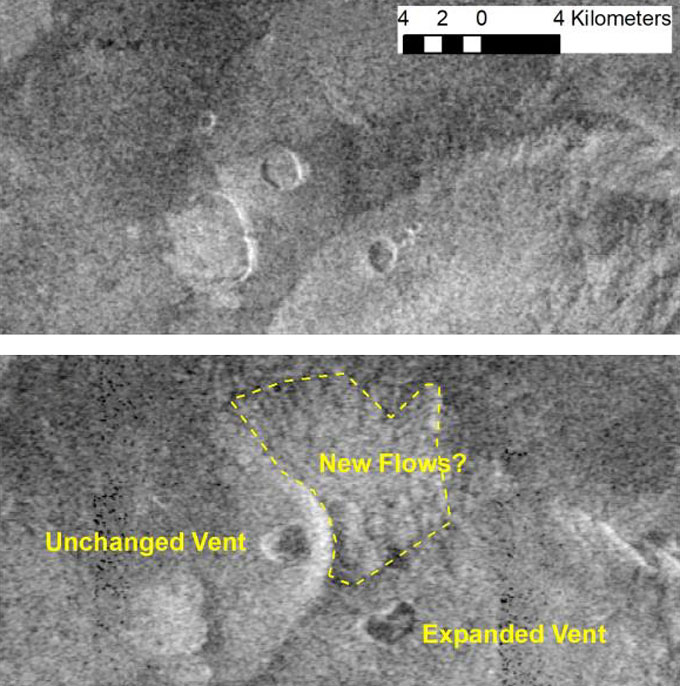This post was originally published on this site
Venus has active volcanism. A new analysis of decades-old images reveals the first definitive sign of a volcano erupting on the hellish planet next door.
NASA’s Magellan spacecraft observed the volcano Maat Mons twice between 1990 and 1992. Sometime in the 243 Earth days between each observation, the volcanic vent appears to have morphed from a 2.2-square-kilometer circle to a 4-square-kilometer blob. That change indicates that an eruption had occurred, researchers report online March 15 in Science and at the Lunar and Planetary Science Conference in The Woodlands, Texas.
“This world is not quiet, not quiescent, not dead,” says planetary scientist Paul Byrne of Washington University in St. Louis who was not involved in the new work.
Venus is about the same size and mass as Earth so it should have a similar amount of internal heat. And that heat must escape somehow. Scientists have long thought that Venus should be volcanically active. “We’ve just never had something we can point to. And now we do,” Byrne says. He’s also confident that volcanoes on Venus can still erupt now.
“There’s no way you have a planet that big that was doing something 30 years ago and stopped,” he says. “It’s definitely still active today.”
Planetary scientist Robert Herrick spotted the change after painstakingly poring through images of the Venusian regions considered most likely to be volcanically active. “This was a needle-in-a-haystack search with no guarantee that the needle exists,” says Herrick, of the University of Alaska Fairbanks.

Much circumstantial evidence for eruptions on Venus has been reported over the decades (SN: 10/22/10; SN: 6/19/15; SN: 10/18/16). But it has been difficult to tell whether any particular change was due to real geology on the ground, or just a mirage. Many reported differences have turned out just to be due to Magellan’s differing viewing angles over successive orbits around Venus.
“Fundamentally, looking at these images is very hard,” says radar scientist Scott Hensley of NASA’s Jet Propulsion Laboratory in Pasadena, Calif. “It’s not like people have not looked [for active volcanism]. People have been looking over the years.”
Still, the vent’s change in the images alone was not enough to convince Hensley and Herrick that they were seeing evidence for active volcanism. So, Hensley ran more than 100 computer simulations of what Maat Mons would have looked like to Magellan under different imaging conditions. “None of them ever looked like [the 4-square-kilometer blob] on the second cycle,” Hensley says. The change must be real, he concluded.
The volcano’s change in shape suggests that it probably didn’t explosively explode like Washington’s Mount St. Helens did in 1980, Byrne says (SN: 11/1/16). Instead, the eruption was probably more like the long, slow lava drainage from Hawaii’s Kilauea volcano in 2018, only bigger, he says (SN: 1/29/19).
The finding gives scientists an idea of what to expect — and some new ideas for research — when upcoming missions return to Venus (SN: 6/2/21). In the late 2020s or early 2030s, NASA plans to launch VERITAS, a satellite that will map the whole planet from space, and EnVision, which will take high-resolution satellite images of targeted regions.
“The cool part is it means that Venus is volcanically active now. In these upcoming missions, we are going to see things happening,” Herrick said in his March 15 talk. “We already had plans to try and look for new things and changes with time in both of those missions … we now know that that’s a valuable thing to do.”
This work is awe-inspiring, said planetary scientist Darby Dyar of Mount Holyoke College in South Hadley, Ma., who was not involved in the new work. “Everybody in this room should be salivating over the features we’re going to see” in images from future missions.
